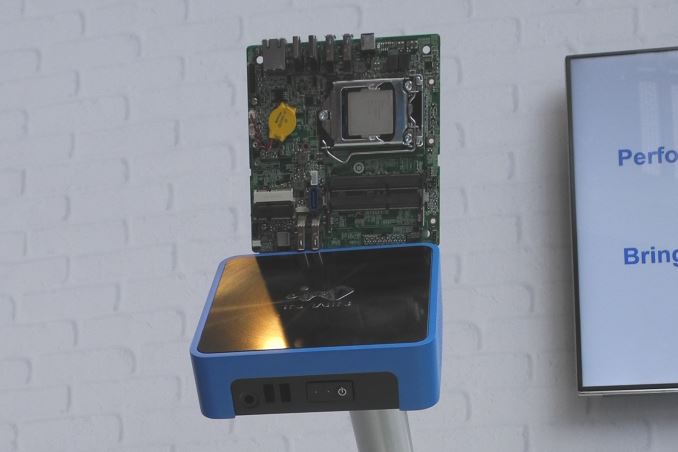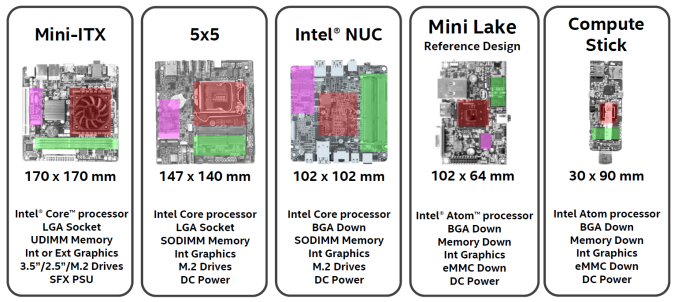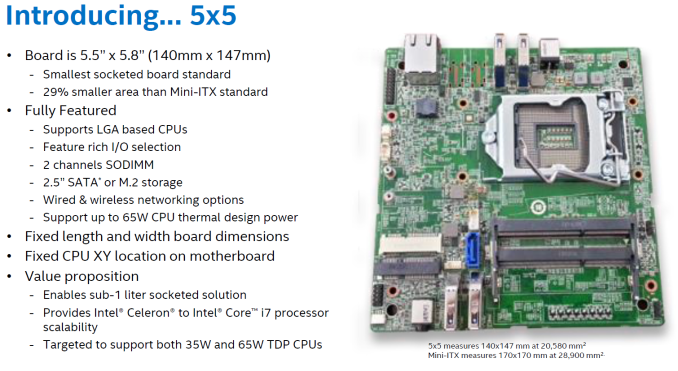Intel Launches New Socketed 5x5 mini-PC Motherboards
by Ganesh T S on August 24, 2015 4:35 AM EST- Posted in
- Trade Shows
- Systems
- Intel
- Motherboards
- Mini-PC
- IDF 2015
- 5x5

Over the last couple of years, the ultra-compact form factor (UCFF) has emerged as one of the bright spots in the troubled PC market. Kickstarted by Intel's NUC (Next Unit of Computing) designs, it has been successfully cloned by other vendors such as GIGABYTE (BRIX), Zotac (C-series nano) and ASRock (Beebox). With platform performance increasing every generation, and performance requirements getting tempered by the rise of the not-so-powerful smartphones and tablets, Intel could pack a heavy punch with their 102x102mm NUC motherboards.
Atom-based units (using Bay Trail) could provide very good performance for most users. Intel tried to shrink the PC even further by releasing a Compute Stick based on the Bay Trail Atom Z series SoCs earlier this year. ECS, with their LIVA designs, has adopted the Mini Lake reference design for their UCFF PCs. All of these UCFF PCs come with BGA CPUs / SoCs. The configurability aspect is minimal from an end-user's perspective. Looking at the mini-ITX form factor immediately leads us to a hole in the mini-PC lineup between it and the NUC.
At IDF last week, Intel quietly launched the new 5x5 motherboard form factor. Coming in at 147x140mm, it is closer to the NUC in the fact that it can operate directly off DC power and takes SODIMM memory. Approaching from the mini-ITX side gives us the LGA socket for a Core processor. Unfortunately, at this size, we have to make do without the full length PCIe slot.
Intel suggests that solutions using the 5x5 boards could come in with a 39mm height for a volume of 0.89L (when using M.2 drives and a heat sink suitable for 35W TDP CPUs). 65W TDP CPUs and 2.5" drive support would obviously increase the height requirements.
Many usage areas which required custom-sized embedded boards (such as digital signage / point of sale terminals / kiosks etc.) have now opened up for the PC, thanks to the NUC and other similar form factors that were introduced over the last year or so. The new 5x5 form factor ensures that a mini-PC is available for every size and performance requirement. As of now, it looks like In-Win has a chassis design ready for the new form factor. We are awaiting more information on the board(s) and availability details.












44 Comments
View All Comments
V900 - Monday, August 24, 2015 - link
You're not even close there...Sure the Skylake parts that Intel just launched has a TDP of 90W. But they'll launch the 30-60W Skylake I7 parts in Q4 this year and Q1-2 next year.
Until then you could put the Broadwell i7 5775C/R in it. It's quad core parts for around 370$ that turbo boosts up to 3.7-3.8 GHZ.
And not only is it a 37-65W processor, it also comes with Iris Pro 5200, which would make it quite an awesome little gaming CPU, without needing a dedicated GPU.
As for what the uses could be, besides a tiny little gaming PC to put under the TV for FullHD gaming, it could also be a potent media center for 4K content. Or a media server capable of transcoding content to several tablets at a time.
Considering how much horsepower the Broadwell Ivy Pro parts have, it could also be great for video editing or photoshop work. Given the tiny size and the sub 400$ price, a photographer could mount it in his car, together with a 13-15 inch screen and use it for photoshop editing on the go.
(Not even sure if the screen is necessary. Just hook it with an iPad and either use a Remote Desktop app or Adobes creative suite...)
Vlad_Da_Great - Sunday, August 30, 2015 - link
Some of the Celeron's run from 4-15W TDP. You don't need to worry for power. You can use battery to run a computer.jardows2 - Monday, August 24, 2015 - link
I hope they don't discontinue the thin Mini-ITX form, as that has options for some very interesting custom designs.I am not sure by the descriptions if the M.2 and the SATA ports can be used at the same time. Does anyone know this detail?
Lonyo - Tuesday, August 25, 2015 - link
"They" can't discontinue thin-ITX, assuming by "they" you don't mean every hardware manufacturer in the world....It's a form factor. it's not owned by anyone.
Of course, this story itself gives no credit to VIA for inventing the whole thing, and lamentably ignores the already existing SFF-SIG and Pico- and Nano-ITX form factors which serve a similar thing.
It would be nice if Intel would use standards with this sort of thing rather than us ending up with 5 different SFF setups because everyone wants to make something similar to Intel but ends up being slightly different with 5x5, NUC, Zbox, Brix etc as mentioned, all of which are entirely non-interoperable in terms of case designs.
Pico and Nano ITX are standards and there's an SFF SIG.